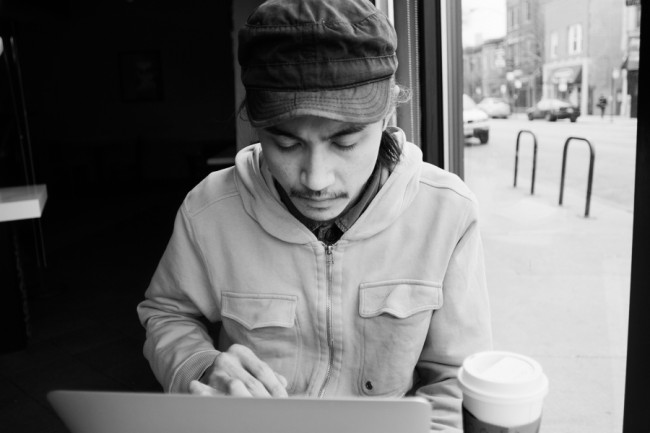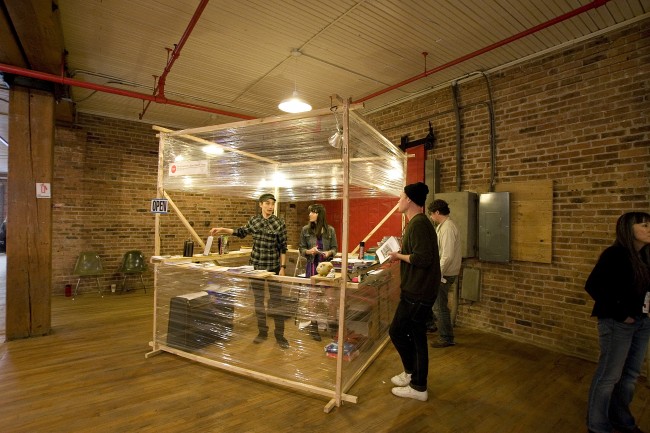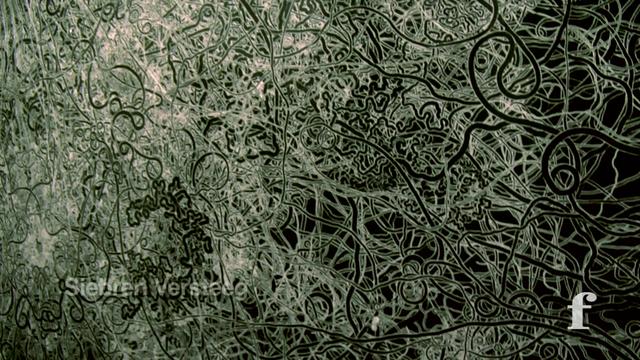Comfortable Out of Balance: Brandon Alvendia and The Storefront project space

Chicago is a hub for some of the most unique multi-purpose artist-run spaces across the map. Much of the city’s apartment gallery history has sprouted from necessity – numerous graduates from the various local art schools leads to an abundance of young emerging artists who are looking to show work, and have accessibility to moderately affordable spaces in which to exhibit (i.e. their apartments, abandoned storefronts, and sometimes even basements). Alternative artist-run spaces that operate outside the boundaries of the market, and that are dedicated to participatory involvement and collaboration from the local community, have always been abundant in Chicago. In 2009, this history was even the subject of an exhibition at Hyde Park Art Center called “Artists Run Chicago.”
Of course, eventually students finish school, artists have children, or curators just get tired of hosting strangers in their living room on Friday nights. After anywhere from a few months to a few years such spaces close, to be replaced by a new crop of apartment galleries. It seems that in recent years, a significant number of Chicago’s best-loved experimental art houses have started to drop like flies; like the dearly missed Minidutch, the musty basement that was Old Gold, Concertina Gallery, the Green Lantern Press gallery (although the Press itself is still operating) and, most recently, Noble and Superior Projects.
I was disappointed to find out that one of Pilsen’s best-known apartment galleries has now followed suit. Ben Russell’s recent decision to become a full-time artist means that the fun and challenging shows at his self-named space, BEN RUSSELL, are ending. Co-curated by Brandon Alvendia and Russell, the space showed local and international artists in rotating, five-month long, five person exhibitions gathered around a theme – allowed for a surprising extension of each individual artist’s studio practice, considering all the restrictions outlined in the five rules of their statement. With policies such as “One artist shall produce a wall-mounted work at a maximum of one half the opposing wall space between the two adjacent doors,” the duo tightly regulated the artist’s material choices and spatial considerations.

But Alvendia has now helped to launch a new wave of alternative artist-run spaces. In 2010, he founded a space in Logan Square called The Storefront with the help of a Propeller Fund Grant. It has been open to the public since the beginning of 2011.
I have always been particularly interested in Alvendia’s approach to the Chicago art scene – to say that he is “involved” would be an understatement. Arts pioneer and creator at large, Alvendia’s latest occupational titles include artist, curator, independent press owner, instructor and gallery director, to name a few. Likewise, The Storefront takes on many functions, and is host to a number of projects including The Silver Galleon Press (which has recently worked with artists such as Vincent Dermody and Eric Fleischauer), as well the in-house screening series The 16:9 Club, and HomeSchool, a public experiment in DIY education (the curriculum is planned in The Storefront space, and the classes given at various instructor’s homes).
F Newsmagazine recently spoke with Alvendia about his latest venture.
Stephanie Cristello: You’ve been asked a lot about your artistic practice and how it has influenced your curatorial approach – could you talk a little bit more about that relationship, specifically in regards to The Storefront? Where do your artistic investigations end, and curatorial projects begin?
Brandon Alvendia: I would more accurately characterize my curatorial approach as nested within, rather than distinct from, the larger artistic practice I maintain. I don’t generally think one mode of operating begins and another ends, it’s more of a constellation of strategies. I feel it is important to challenge or even eliminate the demarcation between disciplines and experiment with new ways of experiencing and evaluating cultural products.
The Storefront is a space that offers me the ability to continually collaborate with a wide variety of critical producers. It is an extension of the studio – as well as an extension of my collaborators’ studios – that I maintain in the rear of the space, which is essentially a 10 x 4’ foot hall. The Storefront is a context that offers a lot of interesting considerations, be they of spatial, conceptual, performative, public or textual concerns. At the end of the day, The Storefront is a space to spend time to talk about interesting things with interesting people, either to hash things out for specific projects or meander aimlessly in conversation (and forget what was said).

In any given day of working, I attend to many different projects at once. One minute I’m processing my inbox, the next minute I’m crafting press releases, the next I’m organizing source materials, the next I’m cutting paper, the next I’m in a studio visit, and the next I’m taking a walk, and the next minute I’m staring blanking looking for the next idea … and then I’ve got the chop saw out and the next I’m running late to teach a class. Multi-tasking is the norm, and being comfortable out of balance is crucial. This is a common modus operandi for many contemporary producers out there, so I try to work in a way that inserts an expansive global critical discourse into a more human-scaled local context (and vice-versa).
SC: Are there any past pieces you’ve done in your personal studio practice that you found helped launch a new curatorial attitude or direction for the space?
BA: I often have trouble making distinctions from one project to the next. They all flow into each another as one giant to-do list. Honestly, I have trouble coming up with good ideas on my own – so I almost always find something I will be working on to respond to. I consider the progression of my practice (and life) as a narrative that can be manipulated and built upon in a cumulative manner. Bringing others’ practices and narratives into my own helps to complicate my process, and in turn draws out potentially surprising results.
I consistently try to get outside of my patterns and encourage others to do the same. The Storefront acts as a vessel to carry a shared ethic between producers and force new connections through collaboration and healthy discussion. If anything, the driving force of The Storefront project is to encourage long visits and deeper participation in contrast to the “one beer and we’re out” pop-by mentality that occurs in making the rounds to see artworks. The Storefront works well for small groups and durational projects hopefully resulting in a more robust and lengthy conversation, though the space is still amenable to having object-driven installations that make conceptual sense in the space.
SC: Your website describes the space as “a multi-purpose non-commercial/non-non-profit institution-as-art project that operates according to the logic of a gift economy.” What exactly is the gift economy?

BA: The notion of a gift economy often has a simplistic, optimistic and generous ring to it, but by nature involves the more or less implicit obligation of reciprocity and sacrifice. Sure, artists can perhaps find a platform to execute ideas not realizable in other places or have their projects promoted through The Storefront, but ultimately everyone gives the gift of time and resources to the bigger cause.
My idea of a gift is about finding an alternate economy, but more so in a way to strengthen bonds and community. As a give and take, my interest in the gift economy is less in the material gift and more in experimenting with the symbolic gift. Ideally the circulation of resources will result in a surplus of subjective creative energy through the shared project, above and beyond the limited capital put in by the collaborators; but the failure of that system can sap as much, if not more, energy than was put in.
For example, when I was awarded the Propeller Fund Grant, my intention was to use the money not to pay for rent, but to support the realization of the different artists’ projects. Generally the money has been used for many Epson inkjet cartridges and various paper stocks for the production of the publications made in concert with the different projects. You might say I am generous by re-gifting the award, but the Storefront gains a certain level of cultural capital by associating with the various projects, and vice-versa. The gift represents all the work and sacrifice put in, often at a loss, to participate in and maintain a vibrant art ecology. Or better yet, a sustainable one.

SC: I know a lot of the shows you have curated in the past (like “Ornament and Crime (and Crime)” at ADDS DONNA) often incorporate a more local group of artists, but you have also frequently exhibited international artists – where do you often look to find work for shows? Do you start with a concept, or do you find certain works act as inspiration or catalysts for a show?
BA: The concepts determine the direction of the research, which can yield ideas for artists or projects I think might fit into the specifics of the context at hand. Though finding artists to work with is a practice like any other, and involves being proactive about reaching out to interesting work, be it in person or through nicely worded emails. All in all, the search is not goal oriented, but organic and accommodating to chance, like any great DADA collage – through continual discussion with peers about what’s relevant to the matter at hand. Motives can also be as superficial as wanting to put big names in a show, or as deeply personal as wanting to support and carve out time to work with friends. For me, the impulse is to heighten discourse with my community, however temporary that may be – the 18 month long email ping pong sessions, one minute stop-and-chat elevator pitches or most often, over drinks.







